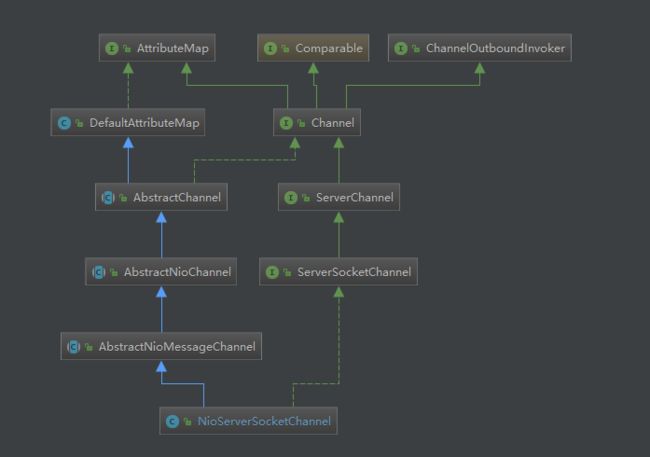一、unsafe是什么?
在netty中一个很核心的组件,封装了java底层的socket操作,作为连接netty和java 底层nio的重要桥梁。
二、unsafe初始化
我们还是从NioServerSocketChannel(服务端channel的NIO实现)开始看,channel会初始化unsafe来和socket打交道。
我们跟踪NioServerSocketChannel的构造函数,需要调用一个newUnsafe的方法构造unsafe的对象。
public abstract class AbstractChannel extends DefaultAttributeMap implements Channel {
...
@Override
public Unsafe unsafe() {
return unsafe;
}
/**
* Create a new {@link AbstractUnsafe} instance which will be used for the life-time of the {@link Channel}
*/
protected abstract AbstractUnsafe newUnsafe();
...
调用子类AbstractNioMessageChannel
@Override
protected AbstractNioUnsafe newUnsafe() {
return new NioMessageUnsafe();
}
最后我们看到unsafe的内部类实现。
private final class NioMessageUnsafe extends AbstractNioUnsafe {
private final List代码有点长,我们这里先不深究。
三、unsafe实现
先分析unsafe的接口
/**
* Unsafe operations that should never be called from user-code. These methods
* are only provided to implement the actual transport, and must be invoked from an I/O thread except for the
* following methods:
*
* - {@link #localAddress()}
* - {@link #remoteAddress()}
* - {@link #closeForcibly()}
* - {@link #register(EventLoop, ChannelPromise)}
* - {@link #deregister(ChannelPromise)}
* - {@link #voidPromise()}
*
*/
interface Unsafe {
/**
* Return the assigned {@link RecvByteBufAllocator.Handle} which will be used to allocate {@link ByteBuf}'s when
* receiving data.
*/
RecvByteBufAllocator.Handle recvBufAllocHandle();
/**
* Return the {@link SocketAddress} to which is bound local or
* {@code null} if none.
*/
SocketAddress localAddress();
/**
* Return the {@link SocketAddress} to which is bound remote or
* {@code null} if none is bound yet.
*/
SocketAddress remoteAddress();
/**
* Register the {@link Channel} of the {@link ChannelPromise} and notify
* the {@link ChannelFuture} once the registration was complete.
*/
void register(EventLoop eventLoop, ChannelPromise promise);
/**
* Bind the {@link SocketAddress} to the {@link Channel} of the {@link ChannelPromise} and notify
* it once its done.
*/
void bind(SocketAddress localAddress, ChannelPromise promise);
/**
* Connect the {@link Channel} of the given {@link ChannelFuture} with the given remote {@link SocketAddress}.
* If a specific local {@link SocketAddress} should be used it need to be given as argument. Otherwise just
* pass {@code null} to it.
*
* The {@link ChannelPromise} will get notified once the connect operation was complete.
*/
void connect(SocketAddress remoteAddress, SocketAddress localAddress, ChannelPromise promise);
/**
* Disconnect the {@link Channel} of the {@link ChannelFuture} and notify the {@link ChannelPromise} once the
* operation was complete.
*/
void disconnect(ChannelPromise promise);
/**
* Close the {@link Channel} of the {@link ChannelPromise} and notify the {@link ChannelPromise} once the
* operation was complete.
*/
void close(ChannelPromise promise);
/**
* Closes the {@link Channel} immediately without firing any events. Probably only useful
* when registration attempt failed.
*/
void closeForcibly();
/**
* Deregister the {@link Channel} of the {@link ChannelPromise} from {@link EventLoop} and notify the
* {@link ChannelPromise} once the operation was complete.
*/
void deregister(ChannelPromise promise);
/**
* Schedules a read operation that fills the inbound buffer of the first {@link ChannelInboundHandler} in the
* {@link ChannelPipeline}. If there's already a pending read operation, this method does nothing.
*/
void beginRead();
/**
* Schedules a write operation.
*/
void write(Object msg, ChannelPromise promise);
/**
* Flush out all write operations scheduled via {@link #write(Object, ChannelPromise)}.
*/
void flush();
/**
* Return a special ChannelPromise which can be reused and passed to the operations in {@link Unsafe}.
* It will never be notified of a success or error and so is only a placeholder for operations
* that take a {@link ChannelPromise} as argument but for which you not want to get notified.
*/
ChannelPromise voidPromise();
/**
* Returns the {@link ChannelOutboundBuffer} of the {@link Channel} where the pending write requests are stored.
*/
ChannelOutboundBuffer outboundBuffer();
}
跟socket交互的核心接口,不建议业务代码直接调用(不然netty还有什么意义呢?)。
我们选择register的接口来看下。
void register(EventLoop eventLoop, ChannelPromise promise);
AbstractChannel.AbstractUnsafe
@Override
public final void register(EventLoop eventLoop, final ChannelPromise promise) {
...
AbstractChannel.this.eventLoop = eventLoop;
if (eventLoop.inEventLoop()) {
register0(promise);
} else {
try {
eventLoop.execute(new Runnable() {
@Override
public void run() {
register0(promise);
}
});
} catch (Throwable t) {
...
}
}
}
private void register0(ChannelPromise promise) {
try {
...
boolean firstRegistration = neverRegistered;
//我们关注这个方法的实现
doRegister();
neverRegistered = false;
registered = true;
...
}
AbstractNioChannel.doRegister。这个方法最后调用的是java nio的register方法。
@Override
protected void doRegister() throws Exception {
...
selectionKey = javaChannel().register(eventLoop().unwrappedSelector(), 0, this);
return;
...
}
四、总结
unsafe是netty的核心组件,负责跟java nio底层打交道。unsafe以内部类的方式实现,同时避免了上层业务的调用。

